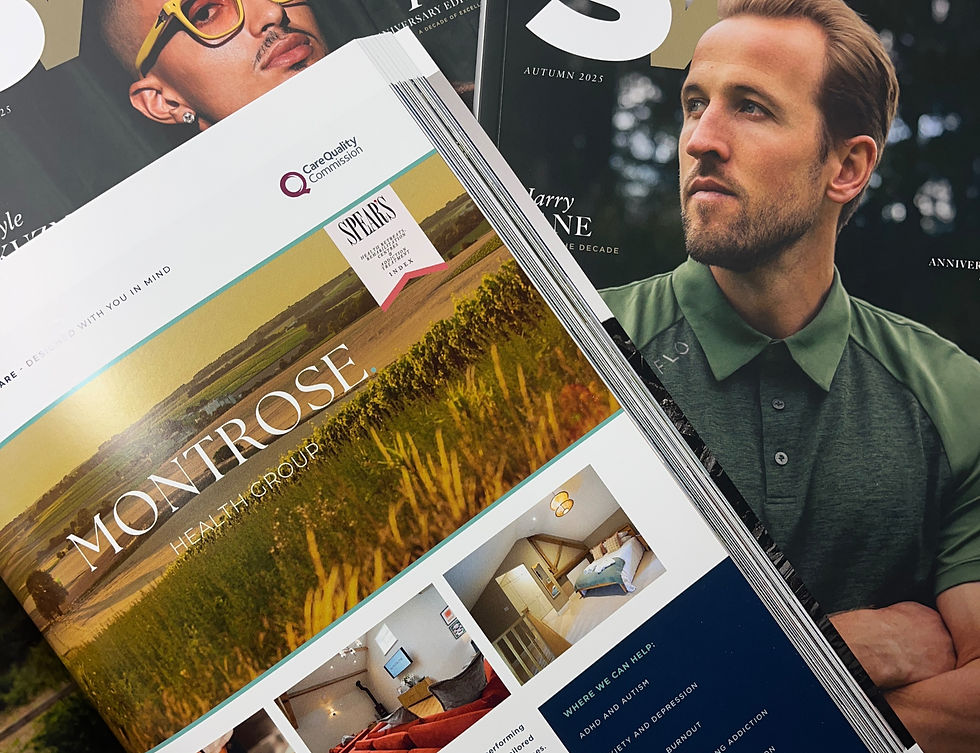“Focus, Energy, and a Different Way of Working”: A High-Profile Lawyer on Living (and Thriving) with ADHD
- Sophie Horn
- Oct 7
- 4 min read
From the Montrose Talks podcast: a candid conversation with Birketts LLP family law partner Tom Quinn about late ADHD diagnosis, work, and what changed when he sought help.
The short version
Tom Quinn is a London-based Family Lawyer Partner, and dad of two who was recently diagnosed with ADHD.
For years he “muddled through” without naming ADHD.
A formal assessment and trial of medication transformed his ability to focus and lifted his day-to-day outlook at work.
He still embraces many ADHD positives such as energy, momentum, and creative problem-solving, especially outside office hours.
“The great thing about being diagnosed with ADHD isn’t the label—it’s knowing what to do next.”
“I always knew I was different—I just didn’t call it ADHD”
Tom describes school and early career years marked by restlessness, short attention spans, and a constant need to move. He wasn’t disengaged; he was overstimulated by distractions and understimulated by tasks that didn’t capture his interest. Like many high performers, he built informal workarounds:
Headphones / noise defenders to shut out ambient noise.
Offline email blocks to remove notification “pings” while drafting.
Frequent movement—short walks to reset and regulate.
These strategies helped him progress to partnership. But as responsibilities grew—leading teams, complex cases, business development—the cognitive load did too. At home, his wife noticed what Tom calls the “can’t-sit-still” energy ramping up and encouraged an assessment.
Assessment, medication, and a mindset shift
A structured ADHD assessment confirmed what Tom suspected. He trialled a short-acting stimulant under psychiatric guidance and noticed two immediate shifts:
Reduced distractibility & sustained focus “Being able to sit and work through a task without the constant pull of something else—game-changer.”
A more positive, balanced mood at work Tom describes moving from “glass half empty” to a steadier, more optimistic baseline during the workday.
He uses medication on workdays and intentionally leans into his natural energy at weekends for family life and chores. For him, that balance preserves the upside of ADHD—pace, enthusiasm, momentum—while smoothing the friction at the desk.
“I like what ADHD brings to my life outside of work... At the office, the meds help me do the job I want to do.”
The highs, lows, and “hyperfocus at the last minute”
Tom recognises familiar ADHD patterns:
Bigger highs and lower lows at work—wins can feel euphoric; setbacks hit harder.
Hyperfocus under pressure—deep, time-bending concentration often arrives closest to deadlines.
Social signals—pre-diagnosis, limited eye contact and fidgeting could read as disinterest. Early on, his family actually noticed more eye contact when he started treatment.
With awareness, he now pairs strengths (energy, fast pattern-spotting, empathy in stressful client situations) with structures that keep cases moving predictably.
What workplaces can do better
Tom sees progress in how firms talk about mental health and neurodiversity—but also pockets of scepticism (“everyone’s got it now”). His view:
Diagnosis is practical, not pejorative. It informs support and management—what helps, what hinders, how to collaborate.
Structure supports everyone. Clear next actions, fewer ambient distractions, and outcome-based check-ins lift performance across the team.
Leaders set the tone. When senior people speak openly, others feel safer to ask for adjustments.
As a partner, he now spots ADHD traits in some clients and adapts: shorter, clearer communications; single-topic emails; agreed routines; and more frequent but briefer check-ins during high-stress legal processes.
Tom’s toolkit: what actually helps
At work
Noise control: noise-cancelling headphones/ear defenders.
Email batching: scheduled offline blocks for deep work.
Single-tasking rituals: quick reset (stand, breathe, water), choose one task, set a 25–40 min timer, then break.
Visible next steps: one page per matter with the very next action and owner.
At home
Movement first: cycling and regular exercise to regulate attention and mood.
Agree “on/off” windows: defined times for admin vs. true downtime to counter the impulse to always be doing.
With others
Say it out loud: share what helps (e.g., “shorter meetings, clear agendas, fewer notifications”).
Shrink the task: if you’re stuck, reduce the first step until it’s trivially small.
Advice to a younger self (and anyone on the fence)
Don’t beat yourself up for thinking differently. You’re not “lazy”—your brain is wired for interest and intensity.
Get assessed. If it is ADHD, you’ll have options; if not, you’ll learn something useful about how you work.
Be selective with medication. For Tom, workday use was the right fit. Your plan should be personal and clinically guided.
Protect the upside. Energy, speed, and creativity are assets. Pair them with routines that keep you steady.
“If you get the diagnosis, do a deep dive. Learn your patterns. Then tailor work and life around them.”
If this resonates
Montrose Health Group supports adults and young people age 7+ with assessment, medication management, and non-medication pathways (ADHD coaching, therapy, nutrition, sleep and exercise planning, and peer groups). We help you design a plan that fits your goals, family, and work.
Thinking about an assessment or just want to talk it through? Get in touch and we’ll help you map the next right step.
Watch the full podcast here:
Disclaimer
This article shares one person’s experience and is not medical advice. ADHD assessment, diagnosis, and treatment (including any decision about medication) should be made in consultation with qualified clinicians. If you have questions about your attention, mood, or functioning at work or home, speak with one of our professionals at Montrose Health Group.






Traveling around the world was a dream come true. Explore more here: 777aa77.com